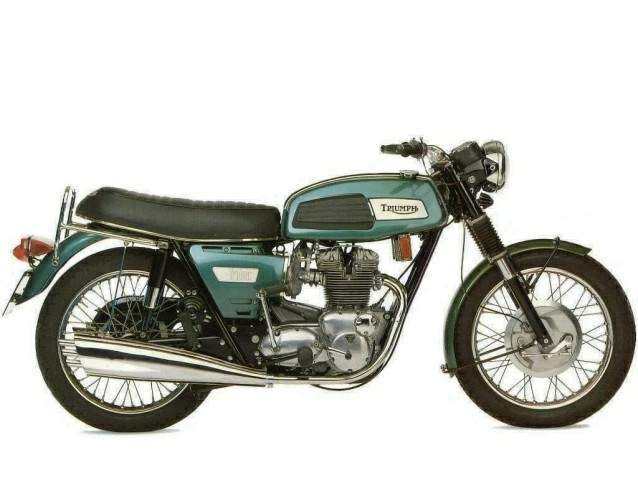
|
|
|
|
|
|
Classic Bikes
Custom Bikes
Individual
Racing Bikes AJP
AJS
Aprilia
Ariel
Avinton / Wakan
Bajaj
Benelli
Beta
Bimota
BMW
Brough Superior
BRP Cam-Am
BSA
Buell / EBR
Bultaco
Cagiva
Campagna
CCM
CF Moto
Combat Motors
Derbi
Deus
Ducati
Excelsior
GASGAS
Ghezzi Brian
Gilera
GIMA
Harley Davidson
Hero
Highland
Honda
Horex
Husaberg
Husqvarna
Hyosung
Indian
Jawa
Kawasaki
KTM
KYMCO
Laverda
Lazareth
Magni
Maico
Mash
Matchless
Mondial
Moto Guzzi
Moto Morini
MV Agusta
MZ / MuZ
NCR
Norton
NSU
Paton
Peugeot
Piaggio
Revival Cycles
Roland Sands
Royal Enfield
Sachs
Sherco
Sunbeam
Suzuki
SWM
SYM
Triumph
TVS
Ural
Velocette
Vespa
Victory
Vincent
VOR
Voxan
Vyrus
Walt Siegl
Walz
Wrenchmonkees
Wunderlich
XTR / Radical
Yamaha
Zero
Video
Technical
Complete Manufacturer List
|
Triumph Trident T150 750
|
| . |
|
Make Model |
Triumph Trident T150 750 |
|
Year |
1969 |
|
Engine |
Tansverse three cylinder, pushrod OHV, 2 valves per cylinder |
|
Capacity |
741 cc / 45.2 cu in |
| Bore x Stroke | 67 x 70.5 mm |
| Compression Ratio | 9.0:1 |
| Cooling System | Air cooled |
| Lubrication | Dry sump |
|
Induction |
3 x 26 mm Amal MK1 carburetors |
|
Ignition |
Individual points & coils |
|
Starting |
Kick |
|
Max Power |
43.3 kW / 58 hp @ 7250 rpm |
|
Transmission |
4 Speed, constant mesh |
|
Final Drive |
Chain |
|
Gear Ratios |
1st 13.00 / 2nd 9.00 / 3rd 6.64 / 4th 5.26:1 |
|
Frame |
Single downtube, duplex cradle |
|
Front Suspension |
Telescopic fork, hydraulic |
|
Rear Suspension |
Swingarm, dual shocks |
|
Front Brakes |
8 in TLS drum |
|
Rear Brakes |
7 in TLS drum |
|
Front Tyre |
3.25-19, Dunlop K70 |
|
Rear Tyre |
4.10-19, Dunlop K70 |
|
Dimensions |
Length: 2184 mm / 86.0 in Width: 840 mm / 33.0 in Height: 1005 mm / 43.5 in |
|
Wheelbase |
1429 mm / 56.3 in |
|
Ground Clearance |
165 mm / 6.5 in |
|
Seat Height |
813 mm / 32 in |
|
Dry Weight |
209 kg / 460 lbs |
|
Fuel Capacity |
19 L / 5.0 US gal / 4.2 Imp gal |
|
Top Speed |
169 km/h / 105 mph |
| . |
The three-cylinder Trident epitomized motorcycling's shift of power in the late Sixties away from old-style British parallel twins toward the new world of Japanese fours. Launched in 1968, the Trident was fast, fine-handling and arguably the first ever superbike. But it lacked the refinement, the reliability and the sheer glamour of Honda's CB750, which arrived a year later to take the wind out of the British bike's sails and its sales. Typically, BSA Triumph (formed by a merger between the two companies) did not capitalize quickly enough on the three-cylinder format, which had been mooted by engineers Bert Hopwood and Doug Hele several years earlier.
By the time the bike was put into production, its pushrod valve operation, drum brakes and lack of electric start were on the verge of becoming old fashioned. The 60bhp triple, however, was certainly no slouch. The factory initially produced two separate models, the Triumph Trident T150 and the BSA Rocket-3, which were near-identical apart from the Rockct-3's angled-forward engine. Both were capable of close to 120mph, with acceleration to match and a thrillingly high-pitched exhaust wail. Triples dominated the racetracks in the early Seventies. The Meriden factory's bikes finished first, second and third at Daytona in 1971 (Dick Mann winning, as he had the year before on a Honda), and in the following seasons notched up dozens of victories at the hands of riders such as John Cooper, Ray Pickrell and Percy Tait. The most famous triple was the production racer nicknamed 'Slippery Sam,' which won consecutive Isle of Man TTs from 1971 to 1975.

Roadster development did not always benefit from the factory's racing commitments, and was further hampered by the firm's growing financial problems. One variation, the X-75 Hurricane, was a custom bike with high bars, a sleek one-piece seat-tank unit and three mufflers aligned up its right side. Stylish, yes - but expensive, impractical and years ahead of its time in 1973. The Trident's first serious revision did not come until 1975 with the T160, which combined handsome new looks of fte own with overdue refinements such as an electric start and disc brakes. The 125mph T160 was the definitive British superbike, but it still lacked the speed and sophistication of the best of the current Japanese opposition. And, to make matters worse, it could do nothing to reverse Triumph's headlong slide toward financial disaster.
Source: Roland Brown
|
Any corrections or more information on these motorcycles will be kindly appreciated. |